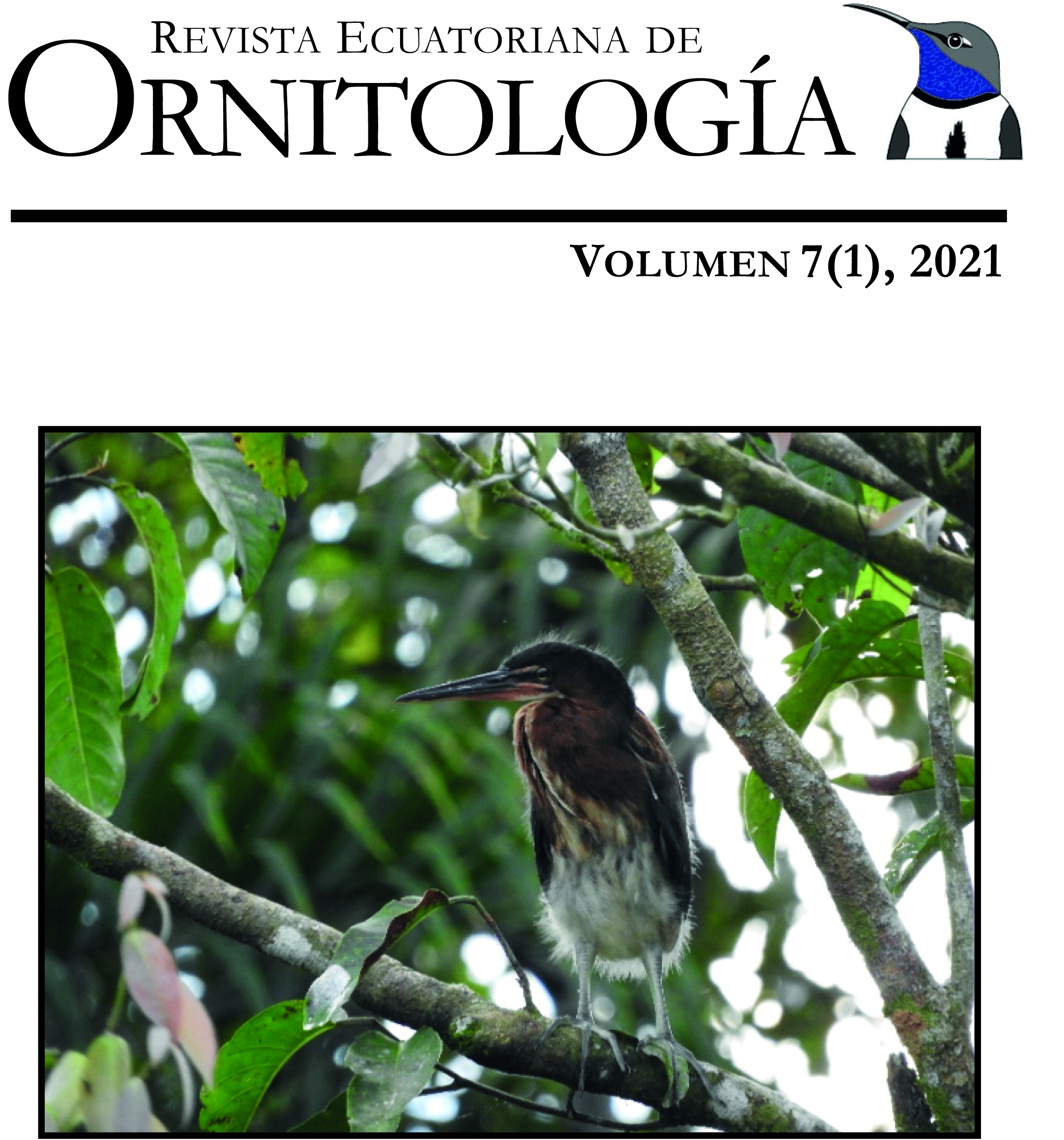FIRST RECORD OF CROWNED SLATY FLYCATCHER Empidonomus aurantiotroacristatus (TYRANNIDAE) IN WESTERN ECUADOR
DOI:
https://doi.org/10.18272/reo.v7i1.1938Keywords:
Austral migrant, Carchi, vagrant, wintering areaAbstract
Crowned Slaty Flycatcher Empidonomus aurantioatrocristatus is an austral migrant that winters in western Amazonia. In this note, I present the first record west of the Ecuadorian Andes. The individual observed was first-year by plumage, and this record correspond to an accidental occurrence due to date and location. Additionally, I discuss other out-of-range and out-of-season records of this species.
Downloads
References
Abbott, D. J., & Finch, D. W. (1978). First Variegated Flycatcher (Empidonomus varius) record for the United States. American Birds, 32, 161-163. URL: https://sora.unm.edu/sites/default/files/journals/nab/v032n02/p00161-p00163.pdf
Burris, C. T. (2019). Northernmost mainland South American record of Crowned Slaty Flycatcher Empidonomus aurantioatrocristatus at Tayrona National Natural Park, Colombia. Cotinga, 41, 111-112. URL: https://www.neotropicalbirdclub.org/cotinga/C41/Cotinga41-190618-digital-hr.pdf
Chesser, R. T. (1995). Biogeographic, ecological, and evolutionary aspects of South American austral migration, with special reference to the family Tyrannidae (Ph.D. dissertation). Louisiana State University, Baton Rouge.
Conover, P. E., & Myers, B. M. (2009). First United States record of Crowned Slaty-Flycatcher (Empidonomus aurantioatrocristatus) from Louisiana. North American Birds, 62, 638-639. URL: http://www.losbird.org/lbrc/csfl_nab.pdf
eBird. (2020). eBird: an online database of bird distribution and abundance. Ithaca, NY: Cornell Lab of Ornithology. URL: https://ebird.org
Freile, J. F., & Poveda, C. (2019, Abril 18). Empidonomus aurantioatrocristatus. En: Freile, J. F., Poveda, C. (Eds.), Aves del Ecuador. Versión 2019.0. Quito, Ecuador: Museo de Zoología, Pontificia Universidad Católica del Ecuador. URL: https://bioweb.bio/faunaweb/avesweb/FichaEspecie/Empidonomus%20aurantioatrocristatus
Freile, J. F., & Restall, R. (2018). Birds of Ecuador. Londres, U.K.: Helm Field Guides.
Hilty, S. L. (2003) Birds of Venezuela. Princeton, NJ: Princeton University Press.
Howell, S. N., Lewington, I., & Russell, W. (2014). Rare birds of North America. Princeton, NJ: Princeton University Press.
Houle, D., & Houle, J. (1993). First record of Variegated Flycatcher for Canada. Birders Journal, 2, 291-300.
Mlodinow, S. G., & Irons, D. S. (2009). First record of Variegated Flycatcher for western North America. Western Birds, 40, 47-49. URL: https://sora.unm.edu/sites/default/files/journals/wb/v40n01/wb-v40n1-p047-p051.pdf
Mobley, J., & Kirwan, G. M. (2020). Variegated Flycactcher (Empidonomus varius), version 1.0. In: del Hoyo, J., Elliott, A., Sargatal, J., Christie, D. A. & de Juana, E. (Eds.), Birds of the World. Ithaca, NY: Cornell Lab of Ornithology. DOI: https://doi.org/10.2173/bow.varfly.01
Nicholson, C. P., & Steadman, S. J. (1988) The official list of Tennessee birds, Addendum I. Migrant, 59, 1-4.
Remsen, J. V., Areta, J. I., Bonaccorso, E., Claramunt, S., Jaramillo, A., Pacheco, J. F., Ribas, C., Robbins, M. B., Stiles, F. G., Stotz, D. F., & Zimmer. K. J. (2020, February 05). A classification of the bird species of South America. American Ornithological Society. URL: www.museum.lsu.edu/~Remsen/SACCBaseline.htm
Ridgely, R. S., & Greenfield, P. J. (2001) The birds of Ecuador. Vol. 1. Status, distribution and taxonomy. Ithaca, NY: Cornell University Press.
Robb, R. (2020). Crowned Slaty Flycatcher (Empidonomus aurantioatrocristatus), version 1.0. In: Schulenberg, T.S. (Eds), Birds of the World. Ithaca. NY: Cornell Lab of Ornithology. DOI: https://doi.org/10.2173/bow.croslf1.01
Robb, R. R., Arendt, D., Larsen, K., & Sherrell, P. (2009). First North American record of Crowned Slaty Flycatcher Griseotyrannus aurantioatrocristatus, at Cerro Azul, Panama. Cotinga, 31, 50-52. URL: https://www.neotropicalbirdclub.org/wp-content/uploads/2016/10/C31-Robbetal.pdf
Schets, P. P. (2018) Crowned Slaty Flycatcher: another new bird for Bonaire and for the Kingdom of the Netherlands. BioNews, 19, 13. URL: https://www.dcnanature.org/wp-content/uploads/2018/11/BioNews19-FlyCatcher.pdf
Schulenberg, T. S., Lane, D. L., O"™Neill, J. P., & Stotz, D. F. (2008). Field identification of juvenile Empidonomus tyrants. Neotropical Birding, 3, 31-36. URL: https://www.neotropicalbirdclub.org/wp-content/uploads/2020/06/NB3-NB-empidonomus.pdf
Somenzari, M., Amaral, P. P., Cueto, V. R., Guaraldo, A. C., Jahn, A. E., Lima, D. M., Lima, P. C., Lugarini, C., Machado, C. G., Martinez, J., Nascimento, J. L. X., Pacheco, J. F., Paludo, D., Prestes, N. P., Serafini, P. P., Silveira, L. F., Sousa, A. E. B. A., Sousa, N. A., Souza, M. A., Telino-Júnior, W. R., & Whitney, B. M. (2018). An overview of migratory birds in Brazil. Papéis Avulsos de Zoologia, 58: e20185803. DOI: https://doi.org/10.11606/1807-0205/2018.58.03
Downloads
Published
How to Cite
Issue
Section
License
Los autores que publiquen en la Revista Ecuatoriana de Ornitología aceptan los siguientes términos:
- Los autores/as conservarán sus derechos de autor y garantizarán a la revista el derecho de primera publicación de su obra, el cuál estará simultáneamente sujeto a la Licencia de Reconocimiento No Comercial de Creative Commons.
- Los autores/as podrán adoptar otros acuerdos de licencia no exclusiva de distribución de la versión de la obra publicada, pudiendo de esa forma publicarla en un volumen monográfico o reproducirla de otras formas, siempre que se indique la publicación inicial en esta revista.
- Se permite y se recomienda a los autores difundir su obra a través de Internet en su repositorio institucional, página web personal, o red social científica (como ResearchGate o Academia.edu).


